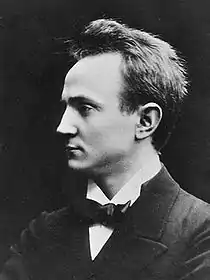Georg Schnéevoigt
Georg Lennart Schnéevoigt (8 November 1872 – 28 November 1947) was a Finnish conductor and cellist, born in Vyborg, Grand Duchy of Finland, which is now in Russia.

Schnéevoigt began his career as a cellist performing throughout Europe in the 1890s.[1] He was principal cellist of the Helsinki Philharmonic from 1896 to 1902. After this, he conducted many orchestras including the Kaim Orchestra (now the Munich Philharmonic Orchestra), Riga Philharmonic Orchestra which he founded, Oslo Philharmonic (1919–1921), the Stockholm Concert Society (later the Royal Stockholm Philharmonic Orchestra), the Sydney Symphony, and the Los Angeles Philharmonic. From 1930 until his death in 1947, Schnéevoigt was chief conductor of the Malmö Symphony Orchestra.
Schnéevoigt was a close friend of composer Jean Sibelius and often performed Sibelius's orchestral music. He conducted the first performance in Finland of Luonnotar in January 1914. He discovered the manuscripts of Sibelius's tone poems "Lemminkäinen and the Maidens" and "Lemminkäinen in Tuonela" (from the Lemminkäinen Suite), which had been thought lost, and gave their first performance since 1894.[2] He also made the first recording of Sibelius's Symphony No. 6.
In Europe young Schneevoigt was considered at best a genius. But by an accounting of the Los Angeles Philharmonic, Schnéevoigt's conducting style was characterised as "flaccid," "paunchy," "phlegmatic," and "plodding," with "little or no sense of direction so far as discipline was concerned." This notwithstanding, his passion for the music of Sibelius was such that he cried when conducting his works.[3]
Vesa Sirén has pointed out that the accounting by Los Angeles Philharmonic is not in accordance with the contemporary critique of Schnéevoigt's conducting. Sirén says that the critiques published in the papers of Los Angeles during 1927-1929 were mainly positive and especially Schnéevoigt's Mahler interpretations were applauded. A reason for Schnéevoigt's apparent loss of reputation, as Sirén reckons, may be that he was succeeded by two legendary conductors – Artur Rodziński and Otto Klemperer – and so his achievements were forgotten.[4]
References
- "FRSO Conductors". Finnish Radio Symphony. Retrieved 2007-05-28.
- "Fragment Found". Time. 9 Oct 1939. Retrieved 2007-04-12.
- Mark Swed (31 August 2003). "The Salonen-Gehry axis". CalendarLive.com. Los Angeles Times. Archived from the original on 11 March 2007. Retrieved 2007-05-28.
- Sirén, Vesa: Suomalaiset kapellimestarit: Sibeliuksesta Saloseen, Kajanuksesta Franckiin, pp. 224–225. Otava, Helsinki, 2010.
External links
| Preceded by none |
Principal Conductor, Royal Stockholm Philharmonic 1915–1924 |
Succeeded by Václav Talich |
| Preceded by Emil Cooper |
Chief Conductor, Latvian National Opera 1929–1931 |
Succeeded by Leo Blech |
| Preceded by Walther Meyer-Radon |
Chief Conductor, Malmö Symphony Orchestra 1930–1947 |
Succeeded by Sten-Åke Axelson |
| Preceded by Robert Kajanus |
Principal Conductor, Helsinki Philharmonic 1932–1940 |
Succeeded by Armas Järnefelt |